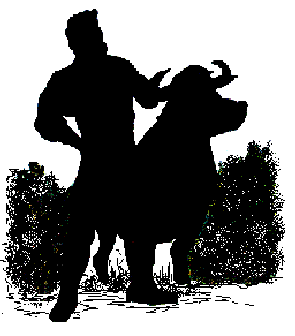
Lucy, Paul Bunyan's cow was not, so far as we can learn, related to Babe. Statements that she was in any way his mother are without basis in fact. No reliable data can be found as to the pedigree of this remarkable dairy animal. There are no official records of her butterfat fat production nor is it known where or how Paul got her. Paul always said that Lucy was part Jersey and part wolf. Maybe so. Her actions and methods of living seemed to justify the allegation of wolf ancestry, for she had an insatiable appetite and a roving disposition.
Lucy ate everything in sight and could never be fed at the same camp with Babe In fact, they quit trying to feed her at all but let her forage her own living. The Winter of the Deep Snow, when even the tallest White Pines were buried, Brimstone Bill outfitted Lucy with a set of Babe's old snowshoes and a pair of green goggles and turned her out to graze on the snowdrifts. At first she had some trouble with the new foot gear but once she learned to run them and shift gears without wrecking herself, she answered the call of the limitless snow fields and ran away all over North America until Paul decorated her with a bell borrowed from a buried church.
In spite of short rations she gave enough milk to keep six men busy skimming the cream. If she bad been kept in a barn and fed regularly she might have made a milking record. When she fed on the evergreen trees and her milk got so strong of White Pine and Balsam that the men used it for cough medicine and liniment, they quit serving the milk on the table and made butter out of it. By using this butter, to grease the logging roads when the snow and ice thawed off, Paul was able to run big logging sleds all summer.
Paul Bunyan loved dogs as well as the next man but never would have one around that could not earn its keep. Paul's dogs had to work, hunt or catch rats. It took a good dog to kill the rats and mice in Paul's camp for the rodents picked up scraps of the buffalo milk pancakes and grew to be as big as two year old bears.
Elmer, the moose terrier, practiced up on the rats when he was a small pup and was soon able to catch a moose on the run and finish it with one shake. Elmer loafed around the cook camp and if the meat supply happened to run low the cook would put the dog out the door and say, "Bring in a moose." Elmer would run into the timber, catch a moose and bring it in and repeat the performance until, after a few minutes work, the cook figured he had enough for a mess and would call the dog in.
Sport, the reversible dog was really the best hunter. He was part wolf and part elephant hound and was raised on bear milk. One night when Sport was quite young, he was playing around in the horse barn and Paul, mistaking him for a mouse, threw a band axe at him. The axe cut the dog in two but Paul, instantly realizing what had happened, quickly stuck the two halves together, gave the pup first aid and bandaged him up.
With careful nursing the dog soon recovered and then it was seen that Paul in his haste had twisted the two halves so that the hind legs pointed straight up. This proved to be an advantage for the dog learned to run on one pair of legs for a while and then flop over without loss of speed and run on the other pair. Because of this he never tired and anything he started after got caught.
The shaggy dog that spent most of his time pretending to sleep in front of the counter in the camp office was Fido, the watch dog. Fido was the bug- bear of the greenhorns. They were told that Paul starved Fido all winter and then, just before payday, fed him all the swampers, barn boys, and student bullcooks. The very marrow was frozen in their heads at the thought of being turned into dog food. Their fears were groundless for Paul would never let a dog go hungry or mistreat a human being. Fido was fed all the watch peddlers, tailors' agents, and camp inspectors and thus served a very useful purpose.
As a hunter, Paul would make old Nimrod himself look like a city dude lost from his guide. He was also a good fisherman. Old- timers tell of seeing Paul as a small boy, fishing off the Atlantic Coast. He would sail out early in the morning in his three- mast schooner and wade back before breakfast with his boat full of fish on his shoulder.
About this time he got his shot gun that required four dishpans full of powder and a keg of spikes to load each barrel. With this gun he could shoot geese so high in the air they would spoil before reaching the ground.
Tracking was Paul's favorite sport and no trail was too old or too dim for him to follow. He once came across the skeleton of a moose that had died of old age and, just for curiosity, picked up the tracks of the animal and spent the whole afternoon following its trail back to the place where it was born.